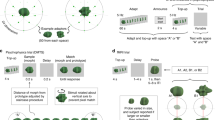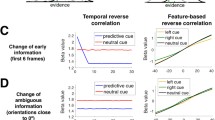Abstract
Subjects were exposed to sequences of colored shapes and required torate each stimulus on a 7-point scale for “novelty.” The sequences were such that 12 hypotheses regarding determinants of subjective novelty could be tested by orthogonal comparisons. The results of two experiments confirmed eight of the hypotheses.
Article PDF
Similar content being viewed by others
Avoid common mistakes on your manuscript.
References
Attneave, F. Physical determinants of the judged complexity of shapes.J. exp. Psychol., 1957, 53, 221–227.
Berlyne, D. E. The arousal and satiation of perceptual curiosity in the rat.J. comp. physiol. Psychol, 1955, 48, 238–246.
Berlyne, D. E. Uncertainty and conflict: a point of contact between information theory and behavior theory.Psychol. Rev., 1957, 64, 329–339.
Berlyne, D. E.Conflict, arousal and curiosity. New York: McGraw-Hill, 1960.
Berlyne, D. E. Motivational problems raised by exploratory and epistemic behavior. In S. Koch (Ed.),Psychology-A study of a science, Vol. 5. New York: McGraw-Hill, 1963.
Berlyne, D. E. Curiosity and exploration.Science, 1966, 153, 25–33.
Berlyne, D.E., Craw, M. A., Salapatek, P. H., &Lewis, J. L. Novelty,complexity,incongruity, extrinsic motivation and the GSR.J. exp. Psychol, 1963, 66, 560–567.
Berlyne, D. E., &Lawrence, G. H. Effects of complexity and incongruity variables on GSR, investigatory behavior, and verbally expressed preference.J. gen. Psychol., 1964, 71, 21–45.
Berlyne, D. E., McDonnell, P., Nicki, R. M., &Parham, L. C. C. Effects of auditory pitch and complexity on EEG desynchronization and on verbally expressed judgments.Canad. J. Psychol., 1967, 21, 346–367.
Blough, D. S. The study of animal sensory processes by operant methods. In W. K. Honig (Ed.),Operant behavior. NewYork: Appleton-Century-Crofts, 1966.
Borresen, C. R., &Lichte, W. H. Shape constancy: dependence upon stimulus familiarity.J. exp. Psychol., 1962, 63, 92–97.
Day, H. Evaluations of subjective complexity, pleasingness and interestingness for a series of random polygons varying in complexity.Percept. & Psychophys., 1967, 2, 281–286.
Granit, R.Receptors and sensory perception. New Haven: Yale University Press, 1935.
Goldstein, A. G. Familiarity and apparent complexity of random shapes.J. exp. Psychol., 1961, 62, 594–597.
Karmel, B. Z. The effect of complexity, amount of contour, element size, and element arrangement on visual preference behavior in the hooded rat, domestic chick, and human infant. Unpublished Ph.D. dissertation, George Washington University, 1966.
Kratin, G. (Analysis of “indifferent” stimulation from the encephalogram in man).Fiziol. Zh. SSSR, 1959, 45 (1), 16–23.
Stevens, S. S., &Volkmann, J. The relation of pitch and frequency: a revised scale.Amer. J. Psychol. 1940, 53, 329–353.
Stouffer, S. A. et al.The American soldier. I. Adjustment during army life. Princeton: Princeton University Press, 1949.
Vanderplas, J. M., &Garvin, E. A. The association value of random shapes.J. exp. Psychol., 1959, 57, 155–163.
Author information
Authors and Affiliations
Additional information
Suported by research grant APB-73 from the National Research Council of Canada. Experiment 1 was reported by L. C. C. Parham in a thesis submitted in accordance with the requirements for the M. A. degree of the University of Toronto.
Rights and permissions
About this article
Cite this article
Berlyne, D.E., Parham, L.C.C. Determinants of subjective novelty. Perception & Psychophysics 3, 415–423 (1968). https://doi.org/10.3758/BF03205748
Accepted:
Issue Date:
DOI: https://doi.org/10.3758/BF03205748




